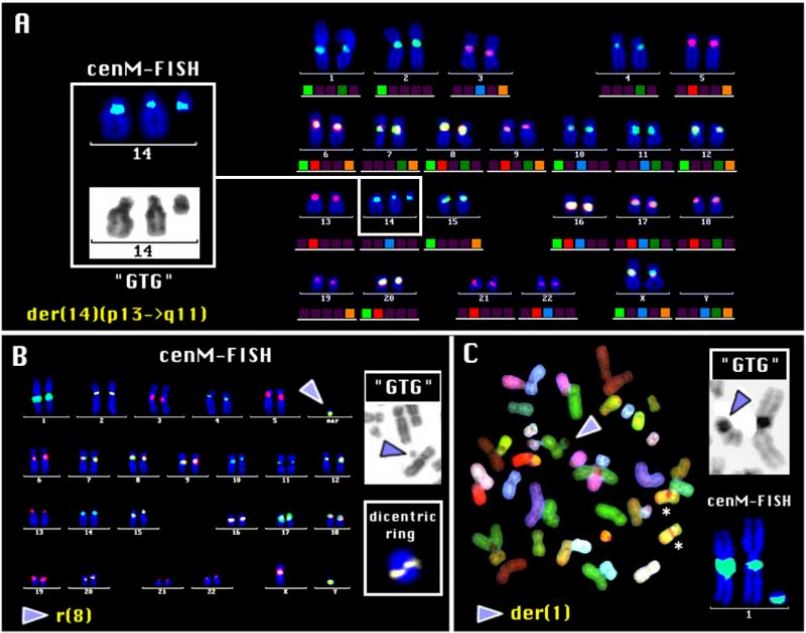Centromere-specific M-FISH (cenM-FISH) Services
Centromere-specific Multicolor-FISH
Centromere-specific multicolor FISH (cenM-FISH) is a new multicolor FISH technique that allows the use of labeled centromere satellite DNA as a probe to simultaneously characterize all human centromeres. This method can quickly identify all human centromeres through individual false staining in a single step and is a powerful tool for molecular cytogenetics. The position of the centromere on human chromosomes is not only in the middle. The chromosomes corresponding to different types of centromeres have different characteristics. The cenM-FISH technology has a wide range of applications. For example, cenM-FISH has been used to identify and characterize rarely described markers that involve heterochromatin materials inserted into uniformly stained areas. In addition, the supernumerary marker chromosomes (SMC) found in prenatal and postnatal diagnosis are usually small abnormal chromosomes that appear in addition to the 46 normal chromosomes. They are also called extra structurally abnormal chromosomes, accessory or B-chromosomes. The cenM-FISH method has been used to analyze SMC. Small SMCs derived from acrocentric chromosomes can also be characterized by acroM-FISH or acro-cenM-FISH. The subcenM-FISH probe set has been successfully applied to characterize the euchromatin content of small additional labeled chromosomes, and to characterize rearranged chromosomes involving breakpoints near the centromere.
 Fig 1. Some centromere-specific multicolor FISH (cenM-FISH) results. (Nietzel A, et al. 2001)
Fig 1. Some centromere-specific multicolor FISH (cenM-FISH) results. (Nietzel A, et al. 2001)
cenM-FISH Related Services
We provide a comprehensive cenM-FISH detection service for the analysis of non-clinical chromatin abnormalities research. The human centromere consists of a large tandem array of repeated alpha satellite DNA. However, the annotation of human centromere repetitive sequences is still incomplete, which greatly hinders the in-depth functional study of these regions essential for chromosome separation. Multicolor FISH using whole chromosome staining FISH is not suitable for characterizing small centromeres and pericromere rearrangements due to technical reasons. In order to monitor the sister chromatid exchange at the centromere due to recombination and mutagenic events, a region-specific probe is used for detection. cenM-FISH fills the gap in multicolor karyotype analysis using whole chromosome probes (WCP) and distinguishes all centromere regions except for highly conserved regions on chromosomes. The service process includes protocol determination, probe preparation, chromosome preparation, FISH hybridization, microscope service and image service.
 Fig 2. CenM-FISH technical service process.
Fig 2. CenM-FISH technical service process.
Available Probe Sets
Our cenM-FISH testing services are supported by the following four specific probe sets. These probe sets feature probes that combine heterochromatic and normal color regions, including ribosomal DNA probes for delineating rDNA. These probe sets contain almost all centromeric probes in human centromere regions and some specific probes in heterochromatin regions and try to cover the entire analysis area. These probe sets are pre-designed solutions, and customers can choose one or more sets of probes for testing services.
 Fig 3. CenM-FISH service optional feature probe sets.
Fig 3. CenM-FISH service optional feature probe sets.
Creative Bioarray provides FISH services based on centromere-specific multicolor technology to help our customers analyze the results more accurately. You will benefit from our technical expertise and equipment platform. If you are interested in our cenM-FISH inspection service, you are welcome to work with us to find a solution that meets your needs. Please contact us for cooperation, we look forward to cooperating with you in the near future.
References
- Nietzel A, Rocchi M, Starke H, et al. A new multicolor-FISH approach for the characterization of marker chromosomes: centromere-specific multicolor-FISH (cenM-FISH)[J]. Human genetics, 2001, 108(3): 199-204.
- Stimpson K M, Sullivan L L, Kuo M E, et al. Nucleolar organization, ribosomal DNA array stability, and acrocentric chromosome integrity are linked to telomere function[J]. PLoS One, 2014, 9(3): e92432.
- Langer S, Fauth C, Rocchi M, et al. AcroM fluorescent in situ hybridization analyses of marker chromosomes[J]. Human genetics, 2001, 109(2): 152-158.
All products and services on this website are only suitable for non-medical purposes.


 Fig 1. Some centromere-specific multicolor FISH (cenM-FISH) results. (Nietzel A, et al. 2001)
Fig 1. Some centromere-specific multicolor FISH (cenM-FISH) results. (Nietzel A, et al. 2001) Fig 2. CenM-FISH technical service process.
Fig 2. CenM-FISH technical service process. Fig 3. CenM-FISH service optional feature probe sets.
Fig 3. CenM-FISH service optional feature probe sets.


